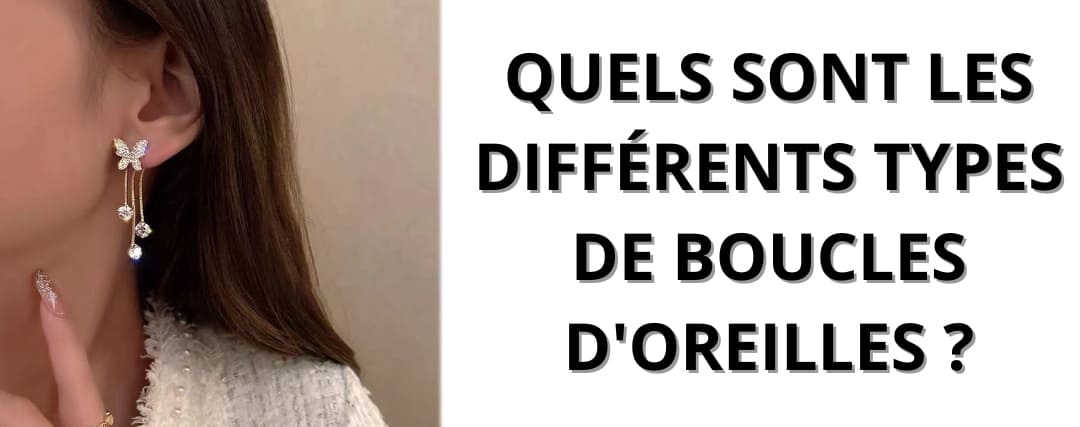Today, we are going to focus on this little accessory that has the power to transform your look in an instant: earrings.
Earrings are more than just jewelry. They are a form of self-expression, a way to complement your facial features and a fashion statement. When chosen carefully, they can say a lot about your style and personality, even before you say a word. But, with countless styles, materials and designs available on the market today, how do you choose the perfect pair for yourself or that special someone?
This article aims to guide you in your choice, by exploring the different types of earrings and their unique charm. We'll dive into the history of earrings, discuss the variety of materials used, and give you an overview of each type.
The history of earrings
Intrigued by how this little accessory came to be? It's time to take a brief trip back in time. Earrings, like other forms of jewelry, have a rich and fascinating history.
Origin and evolution of earrings
Earrings date back to ancient times with the oldest pair ever discovered at almost 5,000 years old. Found in the royal tombs of Ur in Iraq, these earrings were made of gold and were a testament to the craftsmanship and creativity of our ancestors.
From the ancient Egyptians who used earrings as a symbol of wealth and status, to the Romans who considered them the ultimate accessory for women, earrings have been valued throughout history. In ancient Greece, they were often in the form of natural symbols like insects and birds, while in the Byzantine era, complex religious symbols became popular.
The Middle Ages saw the popularity of earrings decline due to the fashions of the time, such as high collars and headdresses that covered the ears. However, earrings made a significant comeback during the Renaissance period, with elaborate designs often encrusted with pearls and precious stones.
Victorian era earrings were typically long and dangling, with diamonds becoming increasingly popular due to new cutting techniques. Fast forward to the 20th century, and we saw the introduction of clip-on earrings, which allowed women to wear stylish earrings without the need for pierced ears.
In the modern era, earrings are more diverse than ever, with styles ranging from traditional to avant-garde. Jewelry designers and manufacturers are now experimenting with materials, techniques and designs, offering a huge range of options to suit all styles and preferences.
Cultural Significance of Earrings Throughout History
In different cultures, earrings had (and often still have) unique symbolism. In some societies, earrings were markers of social status, while others considered them protective amulets. Some Native American tribes, for example, wore earrings as talismans for protection. In Indian culture, earrings, especially those made of gold, are considered a crucial part of a woman's adornment, often given as gifts during important life events.
So there you have it, an overview of the illustrious history of earrings. Isn't it wonderful to think that by wearing earrings you are participating in a tradition that spans millennia? Now that we've covered the past, let's return to the present and explore the wide range of earring types and styles that exist today.
Materials used to make earrings
Now that we've covered the history of earrings, let's dig a little deeper. After all, understanding the materials used in earrings is crucial. This not only helps determine their value, but also their durability, care requirements, and even how they may affect sensitive skin. So without further ado, let's explore some of the most common earring materials you're likely to encounter.
Gold earrings
Gold has been used to make beautiful jewelry, including earrings, for thousands of years. Its resistance to rust, tarnishing and corrosion makes it a popular choice. When shopping for gold earrings, you'll often find that they are measured in carats, which refers to the purity of the gold. The higher the carat, the purer and more valuable the gold.
Remember that pure gold (24 karat) is generally too soft for everyday use, so it is usually alloyed with other metals for strength. This leads to different shades of gold, such as white gold, rose gold and yellow gold.
Silver earrings
Silver, like gold, has been used in jewelry making since ancient times. It is often more affordable than gold, but still offers stunning shine and elegance. The most durable and highest quality type of silver for earrings is sterling silver, which is 92.5% silver and 7.5% other metals, usually copper.
Platinum earrings
Platinum is a rare and durable metal, often considered even more valuable than gold. It is highly resistant to damage and tarnishing, making it a great choice for earrings you want to keep for a long time. Plus, its naturally white luster beautifully enhances the brilliance of diamonds and other precious stones.
Gemstone earrings
Gemstones add a pop of color and personality to earrings. From the deep blue of sapphires to the rich red of rubies, to the vibrant green of emeralds and the clear, timeless elegance of diamonds, gemstones are a way to incorporate personal or symbolic meaning into your earrings. Some people also choose gemstones based on their supposed healing properties.
Each of these materials brings something unique to the table. They vary in price, durability, care instructions and appearance, offering something for everyone. Remember, the gear that's right for you depends on your personal preferences, budget, and lifestyle. Now, with a better understanding of earring materials, we are ready to dive into the different types of earrings available. Get ready to find your perfect pair!
The different types of earrings
After arming ourselves with the knowledge of earring materials, let's move on to the different types of earrings. This piece of jewelry comes in more shapes and sizes than you can imagine, each offering a unique blend of aesthetics and comfort. Understanding each type will help you make an informed decision and find the perfect pair for your style and occasion.
Stud earrings
What are stud earrings?
The stud earring is perhaps the most common and universally loved type of earring. It consists of a single gemstone, pearl or design that appears to float on the earlobe. The simplicity of stud earrings is their ultimate charm, making them a versatile piece for everyday wear.
When and how to wear stud earrings
Whether you're heading to work, running errands, or going to a casual hangout, stud earrings fit in effortlessly. They provide a neat, polished look without drawing too much attention. Diamond stud earrings, for example, are a timeless classic that brings a subtle sparkle to your outfit.
Hoop earrings
What are hoop earrings?
Hoop earrings, characterized by their circular or semi-circular design, are a staple in many jewelry collections. They vary in size, from tiny earrings that hug the earlobe to oversized hoops that make a bold, fashion-forward statement.
Styling Tips for Hoop Earrings
While small hoops can be worn on any casual or formal occasion, large hoops are best reserved for times when you want your earrings to stand out. They pair beautifully with off-the-shoulder tops, high necklines and pulled back hairstyles that allow them to shine.
Dangling and drop earrings
Understanding Teardrop and Dangle Earrings
Teardrop and dangle earrings are designed to flow from the base of the earlobe. While teardrop earrings hang just below the earlobe, dangle earrings swing freely and can extend several inches in length. These earrings come in countless designs, from simple drops to intricate chandeliers.
Best Suitable Occasions for Dangle and Dangle Earrings
Due to their striking design, these earrings are perfect for parties, dinners, or any other event where you want to add a little charm to your ensemble. Make sure to wear your hair up or pulled back to fully showcase these beauties.
Chandelier Earrings
What are chandelier earrings?
Chandelier earrings are known for their intricate, tiered designs and sparkling embellishments. Typically long, these earrings fan out slightly or have multiple tiers, giving them a grand and glamorous appearance.
Pair chandelier earrings with your outfit
Chandelier earrings are ideal for showing off on formal occasions or special events. When wearing them, keep other accessories to a minimum and let the earrings shine. They pair wonderfully with elegant evening wear, especially with updo hairstyles that can highlight their length and design.
Climbing ear cuffs and earrings
What are ear cuffs and climber earrings?
Ear cuffs and climber earrings represent a more modern and edgy take on earrings. Ear cuffs wrap around the outer edge of the ear and do not require piercings to stay in place. On the other hand, climber earrings start at the base of the earlobe and move upward along the edge of the ear.
Wear Ear Cuffs and Climbing Earrings in Style
These statement pieces are fantastic for creating a unique and contemporary look. You can pair them with casual or formal outfits, depending on the design and material of the earrings. Because they highlight the shape of the ear, they are best worn with hairstyles that do not cover the ears.
Conclusion
Whether you're new to earrings or a seasoned connoisseur, remember that these jewelry pieces are more than just accessories. They are an extension of your personal style, a way to express your identity and even convey stories and memories. So, continue to explore, experiment and express yourself through the diverse world of earrings. After all, the perfect pair of earrings isn't just about what's trendy, but what makes you feel confident and unique. Happy accessorizing!





